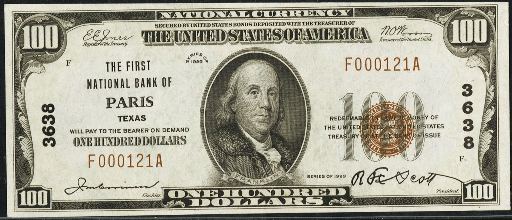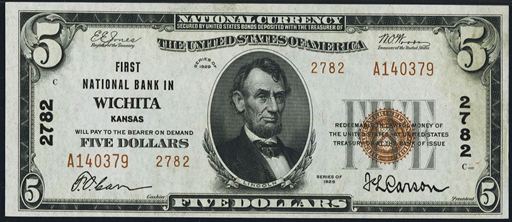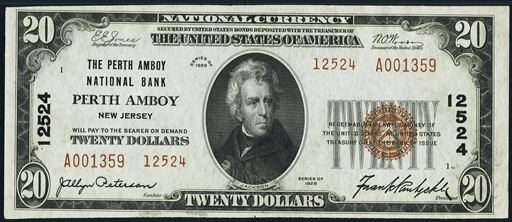The Union Planters National Bank & TC Of Memphis
The Union Planters National Bank & TC Of Memphis in Tennessee printed $6,997,300 dollars worth of national currency. Once a bank issues that much money there really isn’t much room for rare issues. However, there are certainly exceptions to every rule. This national bank opened in 1929 and stopped printing money in 1935, which equals a 7 year printing period. That is obviously a very short period of time. During its life, The Union Planters National Bank & TC Of Memphis issued 7 different types and denominations of national currency. We have examples of the types listed below. Your bank note should look similar. Just the bank name will be different. For the record, The Union Planters National Bank & TC Of Memphis was located in Shelby County. It was assigned charter number 13349.
We buy all national currency. Please call or email us for a quote. Sales@AntiqueMoney.com
The Union Planters National Bank & TC Of Memphis in Tennessee printed 48,280 sheets of Type1 1929 $5 national bank notes. Sadly, based on a number that high, there is basically no chance for these notes to be especially rare. Every 1929 $5 bill has a portrait of Abraham Lincoln on it. This is also the lowest denomination of small size national currency that any bank issued. All serial numbers end with the letter A and start with a letter between A and F. Remember that you can take the total number of sheets printed and multiply it by six get to the actual number of bank notes printed for this denomination. All small size national bank notes were printed on sheets of six.
Series of 1929 Type1 $5 National Bank Note
The Union Planters National Bank & TC Of Memphis printed 16,240 sheets of Type1 1929 $10 national bank notes. Sadly, based on a number that high, there is basically no chance for these notes to be especially rare. Each $10 bill from 1929 has a portrait of Alexander Hamilton on it. The black number written vertically is the charter number. The charter number never affects the value; it is just an identifier. The ten dollar type1 national bank note happens to be the single most common national bank note, with over 65,000 known to exist from all banks. Of course each note is valued based on its condition and rarity. Some are very rare.
Series of 1929 Type1 $10 National Bank Note
The Union Planters National Bank & TC Of Memphis also printed 5,656 sheets of Type1 1929 $20 national bank notes. Sadly, based on a number that high, there is basically no chance for these notes to be especially rare. Andrew Jackson is featured on the front of each 1929 $20 bill. Be sure to take note of the serial number on your specific bank note. If it is 000001 then you can expect a nice premium. There is a special market for serial number one bank notes. Of course, even if the number isn’t #1, it could still be collectible and have a high value just based on its condition and rarity alone.
Series of 1929 Type1 $20 National Bank Note
The Union Planters National Bank & TC Of Memphis also printed 3,214 sheets of Type1 1929 $100 national bank notes. That is a pretty typical sheet output for a national bank during the small size era. Despite saying series of 1929, all type1 national bank notes were actually printed between 1929 and 1933. Exactly 289 national banks printed $100 type1 notes. Most are relatively common. However, as with anything, there are always exceptions to that rule.
Series of 1929 Type1 $100 National Bank Note
The Union Planters National Bank & TC Of Memphis also printed 165,758 individual notes from the type2 1929 $5 national bank note series. A production number higher than 100,000 is a sign that these particular notes won’t be rare. This was an easy and popular denomination for national banks. Five dollars could buy a lot of different things back in 1929 and the early 1930s. 1929 type2 five dollar bank notes are available in quantities today. However, some notes can be extremely rare. The exact value all depends on the bank of issue and condition. Contact us and we would be happy to give a free appraisal.
Series of 1929 Type2 $5 National Bank Note
The Union Planters National Bank & TC Of Memphis also printed 81,459 individual notes from the type2 1929 $10 national bank note series. That is a high printing total. Don’t expect much rarity here, but condition factors can always make common items more valuable. The easiest way to spot the difference between type1 1929 $10 bills and 1929 type2 $10 bills is in the serial number. Type2 notes have a serial number that ends with a number. 1929 type1 notes have a serial number that ends with the letter A. Generally speaking, these $10 bills are rarer than the earlier type1 issues. However, most collectors don’t pay more for that rarity because they look basically the same.
Series of 1929 Type2 $10 National Bank Note
The Union Planters National Bank & TC Of Memphis also printed 16,200 individual notes from the type2 1929 $20 national bank note series. This is a pretty typical print run for type2 national bank notes. Values will be across the board based on demand. One of the great things about 1929 type2 $20 national bank notes is that they really aren’t that old and some can be extremely rare. Until the big head $20 series started there really wasn’t much difference between something printed in 1929 and the same bill printed in 1993. We have bought some examples in the past few months that people just found in their change.
Series of 1929 Type2 $20 National Bank Note



